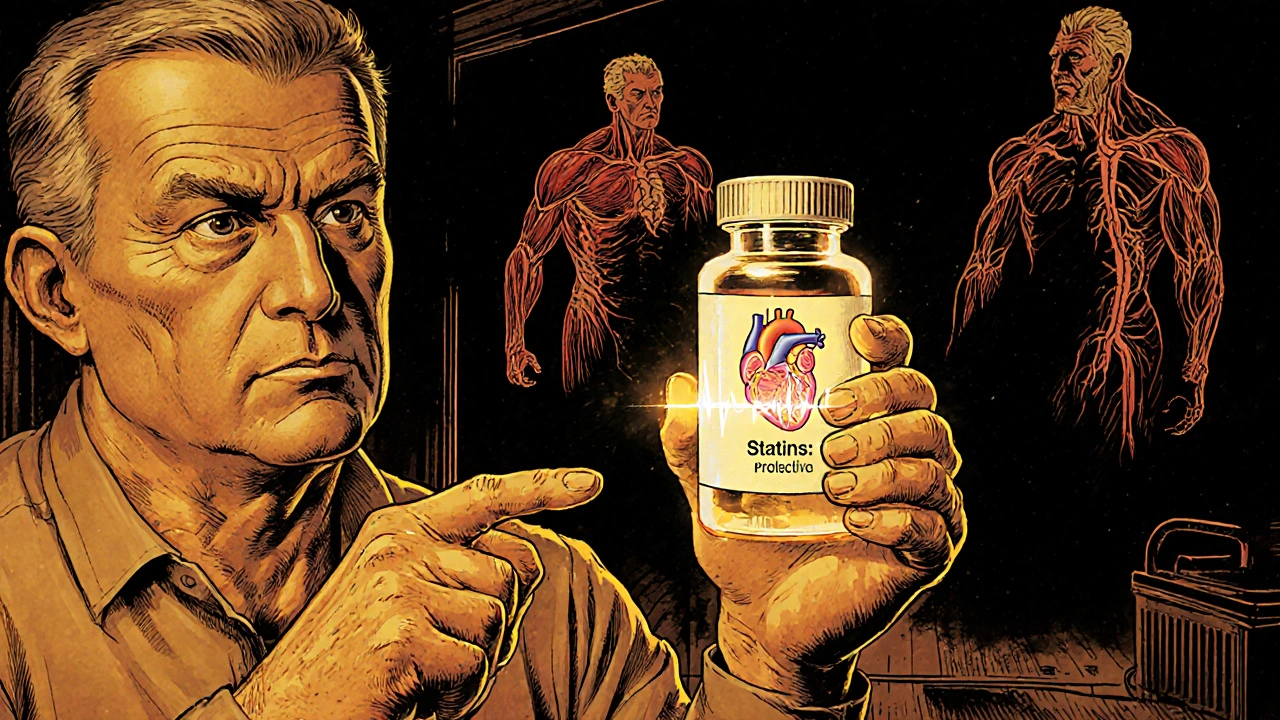For millions of Americans, statins are a daily pill that keeps their heart healthy. But for others, that same pill brings aching legs, sore shoulders, or just a nagging feeling that something’s off. If you’ve been prescribed a statin or are considering one, you’re probably wondering: are the benefits worth the risks? The answer isn’t simple, but it’s clearer than most doctors let on.
How Statins Actually Work
Statins don’t just lower cholesterol-they rewire how your body handles it. These drugs block HMG-CoA reductase, an enzyme in your liver that makes cholesterol. When that enzyme slows down, your liver pulls more LDL (bad cholesterol) out of your blood to compensate. The result? LDL levels drop by 30% to 60%, depending on the statin and dose.
That’s not just a number. Lowering LDL by 1 mmol/L (about 39 mg/dL) cuts your risk of a heart attack or stroke by 22%. Landmark studies like the 4S trial and Heart Protection Study showed that people with existing heart disease cut their risk of dying from a cardiac event by up to 30% after taking statins for a few years. Even people without heart disease but with high risk-like those with diabetes or high blood pressure-see clear benefits.
But statins don’t stop at cholesterol. They also reduce inflammation in artery walls, stabilize plaque so it’s less likely to rupture, and improve how blood vessels relax and function. These effects happen even at doses too low to significantly lower LDL, which is why some experts call them “pleiotropic.” In short, statins protect your arteries in multiple ways, not just by scrubbing out bad cholesterol.
The Real Numbers: Who Benefits Most?
Not everyone gains the same amount from statins. The bigger your risk, the bigger the payoff.
- If you’ve had a heart attack or stroke, statins can cut your chance of another one by about 25% over five years.
- If you have diabetes and are over 40, statins reduce your heart disease risk by roughly 20-25%.
- If you’re healthy but have an LDL over 190 mg/dL, statins cut your lifetime heart disease risk by nearly half.
But if your 10-year risk is below 7.5%, the benefit is tiny-maybe one fewer heart attack per 100 people over five years. That’s why guidelines now focus on risk, not just cholesterol numbers. A 55-year-old with normal LDL but high blood pressure, smoking, and a family history of early heart disease might benefit more than a 65-year-old with LDL 180 but no other risk factors.
Muscle Pain: The Most Common Complaint
Here’s where things get messy. Muscle pain is the #1 reason people stop taking statins. But not all muscle pain is caused by statins.
Studies show 5% to 10% of people on statins report muscle aches, weakness, or cramps. That’s real. But in most cases, blood tests show normal levels of creatine kinase (CK), the enzyme that signals muscle damage. This is called statin-associated muscle symptoms (SAMS)-not true muscle injury.
True rhabdomyolysis, where muscle breaks down dangerously and can damage kidneys, is extremely rare-less than 1 in 10,000 people per year. That’s less likely than being struck by lightning.
So why do so many people blame statins? Partly because muscle aches are common as we age. A 60-year-old might start taking a statin and notice sore legs a few months later. Coincidence? Maybe. But the mind connects the dots. Many patients stop the pill-and feel better. That reinforces the belief that statins caused it.
Real-world data backs this up. On Drugs.com, atorvastatin (Lipitor) has a 5.8/10 rating. Nearly a third of reviewers say they quit because of muscle pain. Reddit threads are full of stories like: “I couldn’t walk up stairs on rosuvastatin. Stopped it. Pain vanished in a week.”

Who’s More Likely to Get Muscle Pain?
Some people are just more vulnerable. Risk factors include:
- Age over 75
- Small body frame
- Chronic kidney or liver disease
- Taking other drugs like fibrates, certain antibiotics, or grapefruit juice (which slows statin breakdown)
- Genetics: a variant in the SLCO1B1 gene makes simvastatin much more likely to cause muscle issues
Some statins are easier on muscles than others. Pravastatin and rosuvastatin tend to cause fewer muscle problems than simvastatin or atorvastatin. Why? They’re processed differently by the liver and don’t build up as much in muscle tissue.
What to Do If You Have Muscle Pain
If you start feeling sore, don’t just quit. Talk to your doctor. Here’s what actually works:
- Check your CK levels-if they’re normal, it’s likely not muscle damage.
- Try a different statin-switching from simvastatin to pravastatin often fixes the problem.
- Lower the dose-many people get the same heart protection on half the dose.
- Take it every other day-some people tolerate alternate-day dosing just fine.
- Try coenzyme Q10-while evidence is mixed, some patients swear it helps. It’s cheap and safe.
And if nothing works? There are non-statin options. Ezetimibe lowers LDL by 15-20% and has almost no muscle side effects. PCSK9 inhibitors (injections) cut LDL by 60% and are very safe-but they cost $10,000 a year. For most people, the right statin at the right dose still beats the alternatives.

Statin Costs and Accessibility
Atorvastatin and simvastatin are now generic. You can get a 30-day supply for as little as $4 at Walmart or through GoodRx. Rosuvastatin costs more-around $15 to $20-but still cheaper than brand-name drugs ever were. Despite this, nearly half of people stop taking statins within a year. The biggest reason? Side effects they think they feel.
But stopping statins isn’t harmless. A JAMA Internal Medicine study found that people who quit statins after a heart attack had a 40% higher chance of another one within a year. The benefit doesn’t disappear overnight-it fades slowly. So if you’re thinking of quitting, talk to your doctor first.
What’s Next for Statins?
Researchers are working on smarter statins. Stanford scientists found that statins protect blood vessels through a mechanism separate from cholesterol lowering. That means future versions might target only the vascular benefits-without touching muscle cells at all.
Genetic testing for the SLCO1B1 gene is already available. If you’re planning to start a statin and have a family history of muscle pain, this test could save you months of trial and error.
For now, the message is simple: if you’re at high risk for heart disease, statins are one of the most effective tools we have. Muscle pain is real for some-but it’s rarely dangerous, and it’s often fixable.
Don’t assume the pain is from the pill. Don’t assume it’s all in your head. Just don’t quit without a plan. Work with your doctor. Try alternatives. Adjust. Test. Most people find a version that works-without giving up the protection statins offer.
Do statins really prevent heart attacks?
Yes, for people at high risk. Large studies show statins reduce heart attacks by 25-30% in those with existing heart disease and by 20-25% in people with diabetes or high LDL. The benefit is strongest when LDL is lowered by 40% or more. For low-risk people, the benefit is smaller but still measurable.
Can I take statins if I have muscle pain?
Maybe. Most muscle pain from statins isn’t dangerous. If your creatine kinase (CK) levels are normal, your doctor can try switching you to a different statin-like pravastatin or fluvastatin-which are less likely to cause pain. Lowering the dose or taking it every other day often helps too. Never ignore severe pain or weakness, though-that could signal a rare but serious condition called rhabdomyolysis.
Are generic statins as good as brand names?
Yes. Generic atorvastatin, simvastatin, and rosuvastatin are chemically identical to their brand-name versions (Lipitor, Zocor, Crestor). They work the same way, have the same side effects, and are held to the same FDA standards. The only difference is cost-generics can be as low as $4 a month.
Does taking coenzyme Q10 help with statin muscle pain?
The science is mixed. Statins lower CoQ10 levels in the body, and some people report less pain when they supplement with 100-200 mg daily. But large clinical trials haven’t proven it works consistently. Still, it’s safe, inexpensive, and worth trying if you’re having muscle issues and other options don’t help.
How long do I need to take statins?
For most people, statins are a long-term or lifelong treatment. The benefits build over time and disappear if you stop. If you quit, your LDL rises again within weeks, and your risk of heart attack returns to what it was before. Only in rare cases-like if you develop a serious side effect or your risk drops dramatically-might you stop safely under medical supervision.
Can I lower my cholesterol without statins?
Yes, but not as effectively. Diet and exercise can lower LDL by 10-15%. Adding ezetimibe gets you another 15-20%. But statins lower LDL by 30-60% on their own. For high-risk patients, non-statin options alone usually aren’t enough to reach target levels. Statins remain the most powerful tool for reducing heart disease risk.
Final Thought: It’s Not All or Nothing
Statins aren’t magic. They’re medicine-powerful, proven, and imperfect. For people at high risk of heart disease, they’re one of the best things medicine has ever offered. For others, the benefit is small, and the side effects matter more.
The key isn’t to fear statins. It’s to understand them. Talk to your doctor. Ask about your real risk. Get your numbers checked. Try alternatives if needed. Don’t quit because you feel a little sore. But don’t push through severe pain either.
There’s a version of statin therapy for almost everyone. You just have to find it.


Write a comment